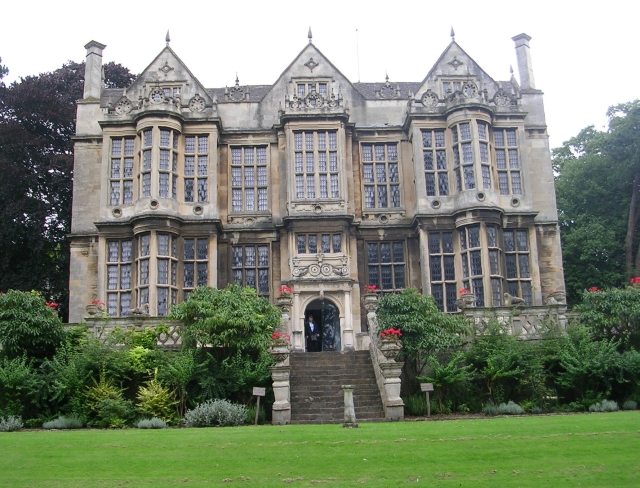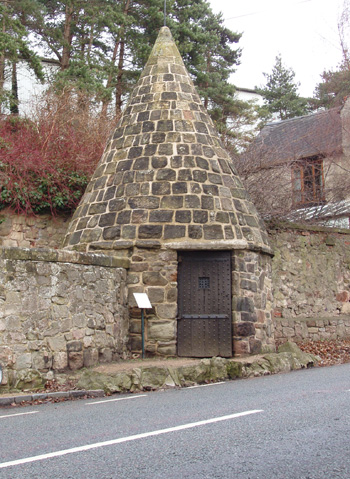|
Bradford-on-Avon
Bradford-on-Avon (sometimes Bradford on Avon) is a town and civil parishes in England, civil parish in west Wiltshire (district), Wiltshire, England, near the border with Somerset. The town's canal, historic buildings, shops, pubs and restaurants make it popular with tourists. The parish had a population of 10,405 at the 2021 census. The history of the town can be traced back to Roman Britain, Roman origins. It has several buildings dating from the 17th century, when the town grew due to the thriving English woollen textile industry. History The earliest evidence of habitation is fragments of Roman Empire, Roman settlements above the town. In particular, archaeological digs have revealed the remains of a large Roman villa with a well-preserved mosaic on the playing fields of St Laurence School. The centre of the town grew up around the ford (crossing), ford across the river Avon, hence the origin of the town's name ("Broad-Ford"). This was supplemented in Norman architecture, ... [...More Info...] [...Related Items...] OR: [Wikipedia] [Google] [Baidu] |
Bradford-on-Avon Tithe Barn
Bradford-on-Avon Tithe Barn is a Grade I listed barn in Pound Lane, Bradford on Avon, Wiltshire, England. It was part of a medieval grange belonging to Shaftesbury Abbey and was built in the early 14th century, with a granary dated to about 1400. It is owned and protected by English Heritage and managed by the Bradford on Avon Preservation Trust. Geography The tithe barn is at Barton Farm on the southern side of Bradford-on Avon in West Wiltshire, to the south-east of Bath. The Kennet and Avon Canal passes close to the south side of the barn. History An early barn, of which no remains survive today, was built on the site of the current barn around 1300. The current barn dates to the 1330s, probably , and was certainly built before 1367. It originally belonged to the nuns of the nearby Shaftesbury Abbey in Dorset, the richest nunnery in England. It was used for storage of tithes during the Middle Ages. The abbey was entitled to 10% of the produce of its tenants. When Shaftesb ... [...More Info...] [...Related Items...] OR: [Wikipedia] [Google] [Baidu] |
The Hall, Bradford-on-Avon
The Hall, at times known as Kingston House and The Duke's House, is a Grade I listed Jacobean mansion in Bradford-on-Avon, Wiltshire, England. History The Hall was built around 1610 for John Hall, a wealthy mill owner, and is at the east end of the town. The Hall family of Bradford can be traced back to at least the 13th century, under the name of "De Aulâ" or "De la Sale" (''salle'' being French for hall). John Hall's grandson, also named John Hall, had no legitimate children and left his estate to his great-niece Rachel Baynton. She later married William Pierrepont, who became Duke of Kingston-upon-Hull, giving the house its alternate names. After the second Duke died without issue, the house was sold to Thomas Divett, in 1802, who established a woollen mill, and sublet the house, which fell into disrepair. In 1848, the house was sold to Stephen Moulton, who undertook major restorations. During the restoration, many old documents were discovered, which were catalogued by ... [...More Info...] [...Related Items...] OR: [Wikipedia] [Google] [Baidu] |
Wiltshire
Wiltshire (; abbreviated to Wilts) is a ceremonial county in South West England. It borders Gloucestershire to the north, Oxfordshire to the north-east, Berkshire to the east, Hampshire to the south-east, Dorset to the south, and Somerset to the west. The largest settlement is Swindon, and Trowbridge is the county town. The county has an area of and a population of 720,060. The county is mostly rural, and the centre and south-west are sparsely populated. After Swindon (183,638), the largest settlements are the city of Salisbury (41,820) and the towns of Chippenham (37,548) and Trowbridge (37,169). For local government purposes, the county comprises two unitary authority areas: Swindon and Wiltshire. Undulating chalk downlands characterize much of the county. In the east are Marlborough Downs, which contain Savernake Forest. To the south is the Vale of Pewsey, which separates the downs from Salisbury Plain in the centre of the county. The south-west is also downland, ... [...More Info...] [...Related Items...] OR: [Wikipedia] [Google] [Baidu] |
Melksham And Devizes (UK Parliament Constituency)
Melksham and Devizes is a constituency of the House of Commons in the UK Parliament. Further to the completion of the 2023 Periodic Review of Westminster constituencies, it was first contested at the 2024 general election, when it was won by Brian Mathew of the Liberal Democrats. He defeated Conservative former cabinet minister Michelle Donelan, who had been MP for Chippenham from 2015 to 2024. Boundaries The constituency is composed of the following electoral districts of Wiltshire (as they existed on 4 May 2021): * Bowerhill; Box & Colerne; Bradford-on-Avon North; Bradford-on-Avon South; Bromham, Rowde & Roundway; Calne South; Devizes East; Devizes North; Devizes Rural West; Devizes South; Holt; Melksham East; Melksham Forest; Melksham South; Melksham Without North & Shurnhold; Melksham Without West & Rural; The Lavingtons; Urchfont & Bishops Cannings; Winsley & Westwood. It comprises the following areas: * The towns of Melksham and Bradford-on-Avon, transferred from Chi ... [...More Info...] [...Related Items...] OR: [Wikipedia] [Google] [Baidu] |
St Laurence School
St Laurence School is a coeducational secondary school and sixth form in Bradford on Avon, Wiltshire, England. It became an Academy in August 2011. Besides Bradford on Avon, the school takes pupils from Atworth, Monkton Farleigh, Winsley, Limpley Stoke, South Wraxall, Bradford Leigh, Trowbridge and Melksham. It is in the northwest of the town, off the road towards Little Ashley. History The school was founded in 1980 as a result of the merger of Fitzmaurice Grammar School and Trinity Secondary Modern school, opening on the Trinity site. It is named after the historically-important Saxon St Laurence's Church, Bradford-on-Avon. Under the Specialist schools programme of 1997–2010 the school had Arts College status, resulting in extra investment in drama, music and dance facilities. The school's teaching departments are spread across numerous buildings on the school site. The site also has a large sports hall and several sports courts, pitches and playing fields. A lecture ... [...More Info...] [...Related Items...] OR: [Wikipedia] [Google] [Baidu] |
Swan Hotel, Bradford-on-Avon
The Swan Hotel is a Grade II* listed hotel in Church Street, Bradford-on-Avon Bradford-on-Avon (sometimes Bradford on Avon) is a town and civil parishes in England, civil parish in west Wiltshire (district), Wiltshire, England, near the border with Somerset. The town's canal, historic buildings, shops, pubs and restauran ..., Wiltshire, England. It is of uncertain age but probably dates from the seventeenth century. References Grade II* listed buildings in Wiltshire Grade II* listed hotels Buildings and structures completed in the 17th century Hotels in Wiltshire Bradford-on-Avon {{Wiltshire-struct-stub ... [...More Info...] [...Related Items...] OR: [Wikipedia] [Google] [Baidu] |
Village Lock-up
A village lock-up is a historic building once used for the temporary detention of people in England and Wales, mostly where official prisons or criminal courts were beyond easy walking distance. Lockups were often used for the confinement of drunks, who were usually released the next day, or to hold people being brought before the local magistrate. The archetypal form comprises a small room with a single door and a narrow slit window, grating or holes. Most lock-ups feature a tiled or stone-built dome or spire as a roof and are built from brick, stone and/or timber. Such a room was built in many shapes; many are round, which gives rise to a sub-description: the punishment or village round-house (). Village lock-ups, though usually freestanding, were often attached to walls, tall pillar/tower village crosses or incorporated into other buildings. Varying in architectural strength and ornamentation, they were all built to perform the same function. Nicknames and forms They have a ... [...More Info...] [...Related Items...] OR: [Wikipedia] [Google] [Baidu] |
Stephen Moulton
Stephen Moulton (7 July 1794 – 26 April 1880) was an Englishman who, as an agent of the American rubber pioneer Charles Goodyear, first brought samples of vulcanized rubber to the United Kingdom. Biography Moulton, who was born in Whorlton, County Durham, subsequently shared the samples with Thomas Hancock, who then beat Goodyear to a UK patent for the vulcanization process by a matter of a few weeks in 1843. After various disputes with Hancock and Goodyear over patents and manufacturing rights, Moulton established his own factory in 1848 at Kingston Mill near Bradford-on-Avon, Wiltshire, England. His company, S.Moulton & Co., specialised in rubber applications for engineering industries and in 1855 acquired the Middle Mill adjacent to the existing factory along with the nearby Staverton woollen mill between 1851 and 1860. With the increasing importance of the British railway industry he concentrated on providing rubber suspension systems and components for railway ca ... [...More Info...] [...Related Items...] OR: [Wikipedia] [Google] [Baidu] |
Wiltshire (district)
Wiltshire is a Unitary authorities of England, unitary authority area in the ceremonial county of Wiltshire, South West England. It was formed in April 2009 following the abolition of Wiltshire County Council and the districts of Kennet District, Kennet, North Wiltshire, Salisbury District, Salisbury, and West Wiltshire. They were all replaced by Wiltshire Council, which is based at County Hall, Trowbridge, County Hall in Trowbridge. The remaining part of the ceremonial county is the Borough of Swindon, administered by a separate unitary authority. In 2022 it had a population of 515,885. Salisbury is the only city in the district and its largest settlement. After the city, the next largest urban areas are Chippenham and Trowbridge. History Until 2009, Wiltshire had four districts – Kennet District, Kennet, North Wiltshire, Salisbury District, Salisbury, and West Wiltshire – together with the Borough of Swindon which had been made a separate Unitary authorities of England, u ... [...More Info...] [...Related Items...] OR: [Wikipedia] [Google] [Baidu] |
Battle Of Lansdowne
The First English Civil War battle of Lansdowne, or Lansdown, was fought on 5 July 1643, at Lansdowne Hill, near Bath, Somerset, England. Although the Royalists under Lord Hopton forced the Parliamentarians under Sir William Waller to retreat from their hilltop position, they suffered so many casualties themselves and were left so disordered and short of ammunition that an injured Hopton was forced to retire. Prelude By late May 1643, Lord Hopton's Royalist army had captured most of the south-west of England. Joined by the Marquess of Hertford, he then advanced eastward into Parliamentarian-held territory. Sir William Waller's army held Bath, to obstruct their further advance. On 2 July 1643 the Royalists seized the bridge at Bradford-on-Avon. On 3 July, skirmishes took place at Claverton and at Waller's positions south and east of Bath. Waller retired to a strong position on Lansdowne Hill, north-west of Bath while the main Royalist force moved north through Batheas ... [...More Info...] [...Related Items...] OR: [Wikipedia] [Google] [Baidu] |
Roman Villa
A Roman villa was typically a farmhouse or country house in the territory of the Roman Republic and the Roman Empire, sometimes reaching extravagant proportions. Nevertheless, the term "Roman villa" generally covers buildings with the common features of being extra-urban (i.e. located outside urban settlements, unlike the ''domus'' which was inside them) and residential, with accommodation for the owner. The definition also changed with time: the earliest examples are mostly humble farmhouses in Italy, while from the Roman Republic, Republican period a range of larger building types are included. Typology and distribution The present meaning of "villa" is partially based on the fairly numerous ancient Roman written sources and on archaeological remains, though many of these are poorly preserved. The most detailed ancient text on the meaning of "villa" is by Varro (116–27 BC) dating from the end of the Republican period, which is used for most modern considerations. But R ... [...More Info...] [...Related Items...] OR: [Wikipedia] [Google] [Baidu] |



